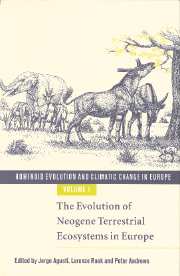Book contents
- Frontmatter
- Contents
- List of contributors
- Acknowledgements: The European Science Foundation
- 1 Introduction
- PART I Palaeogeography of the circum-Mediterranean region
- PART II Miocene mammalian successions
- PART III Palaeoenvironments: non-mammalian evidence
- PART IV Palaeoenvironments: mammalian evidence
- 19 Shrews (Mammalia, Insectivora, Soricidae) as paleoclimatic indicators in the European Neogene
- 20 Mammal turnover and global climate change in the late Miocene terrestrial record of the Vallès-Penedès Basin (NE Spain)
- 21 Palaeoenvironments of late Miocene primate localities in Macedonia, Greece
- 22 The paleoecology of the Pikermian Biome and the savanna myth
- 23 Vicariance biogeography and paleoecology of Eurasian Miocene hominoid primates
- Index
21 - Palaeoenvironments of late Miocene primate localities in Macedonia, Greece
from PART IV - Palaeoenvironments: mammalian evidence
Published online by Cambridge University Press: 15 December 2009
- Frontmatter
- Contents
- List of contributors
- Acknowledgements: The European Science Foundation
- 1 Introduction
- PART I Palaeogeography of the circum-Mediterranean region
- PART II Miocene mammalian successions
- PART III Palaeoenvironments: non-mammalian evidence
- PART IV Palaeoenvironments: mammalian evidence
- 19 Shrews (Mammalia, Insectivora, Soricidae) as paleoclimatic indicators in the European Neogene
- 20 Mammal turnover and global climate change in the late Miocene terrestrial record of the Vallès-Penedès Basin (NE Spain)
- 21 Palaeoenvironments of late Miocene primate localities in Macedonia, Greece
- 22 The paleoecology of the Pikermian Biome and the savanna myth
- 23 Vicariance biogeography and paleoecology of Eurasian Miocene hominoid primates
- Index
Summary
The late Miocene deposits of northern Greece have been known since the beginning of the twentieth century (Andrews, 1918; Arambourg & Piveteau, 1929). They have yielded several fossil mammalian localities which have been dated to Vallesian and Turolian. Arambourg & Piveteau (1929) published faunal lists and fossil description of several localities found by Arambourg during the First World War. The Arambourg collection is housed in the Museum national d'Histoire naturelle, Paris, and it is labeled ‘Salonique’ in most of the following publications, but the fossils have been recovered from several sites and it is difficult to know exactly where they have come from. The age of the faunas was given as ‘Pontian’. Andrews's material is in the Natural History Museum, London, and was found in an unknown locality near the village of Diavata (Koufos, 1985). Field researches were carried out again in the beginning of the 1970s. They allowed the discovery of numerous new fossiliferous sites and they lead to the conclusion that the ages of the faunas, although late Miocene, were quite different from each other. Indeed the oldest ones have been dated to Vallesian (10 to 9 Ma) and the more recent ones to late Turolian (6 Ma). These localities have a great importance insofar as they have, in a quite small area, hominoid primates and cercopithecoids. Hominoids are recovered from Vallesian sites and the cercopithecoids from the Turolian ones. The locality of Pyrgos near Athens has a faunal list which sounds Turolian although this locality has yielded a mandible of hominoid. But the fossils were identified from poor specimens and these identifications need to be reappraised (see Bonis & Koufos, this volume).
- Type
- Chapter
- Information
- Hominoid Evolution and Climatic Change in Europe , pp. 413 - 435Publisher: Cambridge University PressPrint publication year: 1999
- 8
- Cited by



